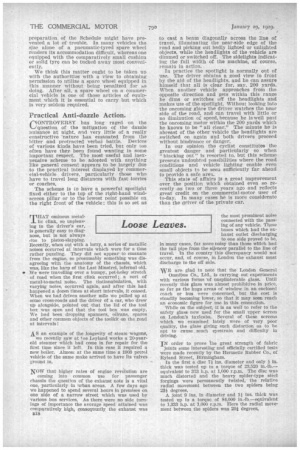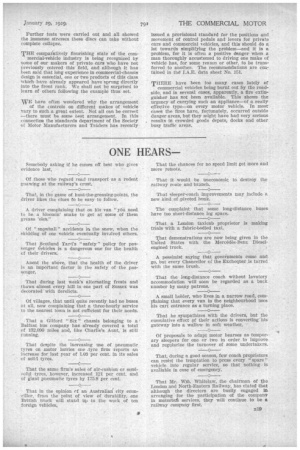Loose Leaves.
Page 2

Page 3

If you've noticed an error in this article please click here to report it so we can fix it.
filHAT ominous metallic clink, so unpleasing to the driver's ear, is generally easy to diagnose, but is not always due to piston-slapping. Recently, when out with a lorry, a series of metallic noises occurred at intervals which were for a time rather puzzling. They did not appear to emanate from the engine, so presumably something was disagreeing with the anatomy Of the chassis, which was, like the harp of the Last Minstrel, infernal old.
• We were travelling over a bumpy, pot-holey stretch of road when the first clink occurred; a sort of metal-to-metal noise. The tintinnabulation, with varying notes, occurred again, and after this had happened a dozen times at short intervals, it ceased. When we had driven another mile we pulled up at some cross-roads and the driver of a car, who drew up alongside, pointed out that the lid of the tool box was open and that the tool box was empty. We had been dropping spanners, oilcans, spares and other common objects of the toolkit on the road at intervals!
AS an example of the longevity of steam wagons, we recently saw at time Leyland works a 20-yearold steamer which had come in for repair for the first time since it left In this case it required a new boiler. Almost at the same time a 1903 petrol vehicle of the same make arrived to have Its valves ground in.
NOW that higher rates of engine revolution are coming into common use for passenger chassis the question of the exhaust note is a vital one, particularly in urban areas. A few days ago we happened to spend several hours in premises on one side of a narrow street which was used by various bus services. As there were no side turnings of importance the average speed attained was comparatively high, ceusequently the exhaust was 318
the most prominent noise connected with the passing of any vehicle. Tiwse buses' which had the -exhaust outlet discharging to one side proved to be, In many cases, far more noisy than those which had the tail pipe from the silencer parallel to the line of travel. In the country this discrepancy would not occur, and, of course, in London the 'exhaust must discharge to the off side.
WE are glad to note that the London General Omnibus Co., Ltd., is carrying out experiments with various forms of unsplinterable glass. Until recently this glass was almost prohibitive in price, so far as the huge areas of window in an enclosed coach or bus were concerned, but the cost is steadily becoming lower, so that it may soon reach an economic figure for use in this connection.
While on the subject, it is as well to refer to the safety glass now used for the small upper screen on London's taxicabs. Several of these screens which we examined lately were of very poor quality, the glass giving such distortion as to be apt to cause much eyestrain and difficulty in driving.
IN order to prove the great strength of fabric joints some interesting and officially certified tests were made recently by the Hermetic Rubber Co., of Ryland Street, Birmingham.
In the first a disc 7i ins, diameter and only 1 in. thick was tested up to a torque of 23,520 in.-lb.-equivalent to 373 h.p. at 1,000 r.p.m. The disc was much distorted and the heavy spider-type steel forgings were permanently twisted, the relative radial movement between the two spiders being 23i degrees.
A joint 9 ins, in diameter and 11 ins. thick was tested up to a torque of 84,000 in.-lb.—equivalent to 1,333 11.p. at 1,000 ramie Here the radial movement between the spiders was 20} degrees, Further tests were carried out and all showed the immense stresses these discs can take without complete collapse.
THE comparatively flourishing state of the com mercial-vehicle industry is being recognized by some of our makers of private cars who have not Previously entered this field, and although it has been said that long experience in commercial-chassis design is essential, one or two products of this class which have already appeared have sprung directly into the front rank. We shall not be surprised to learn of others following the example thus set.
WE have often wondered why the arrangement
of the controls on different makes of vehicle vary to such.a great extent. Not all can be correct —there must be some best arrangement. In this connection the standards department of the Society of Motor Manufacturers and Traders has recently Issued a provisional standard for the positions and movement of control pedals and levers for private cars and commercial vehicles, and this should do a lot towards simplifying the problem—and it is a problem, for it is often a positive danger when a man thoroughly accustomed to driving one make of vehicle has, for some reason or other, to be transferred to another. The recommendations are contained in the I.A.E. data sheet No. 151.
THERE have been too many cases lately of
commercial vehicles being burnt out by the roadside, and in several cases, apparently, a fire extinguisher has not been available. This shows the urgency of carrying such an appliance—of a really effective type—on every motor .vehicle. In most eases the fires have, fortunately, occurred outside • danger areas, but they might have had very serious results in crowded goods depots, docks and other busy traffic areas,


































